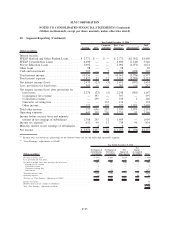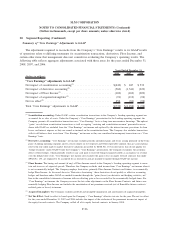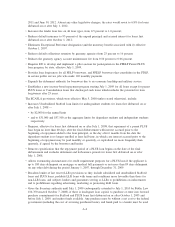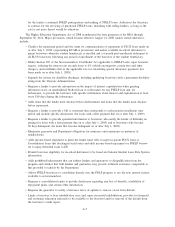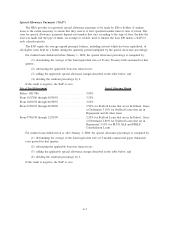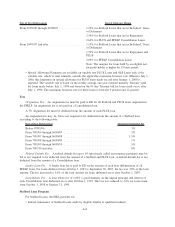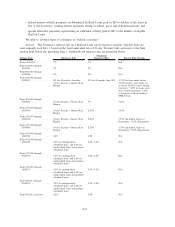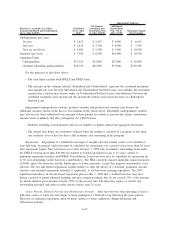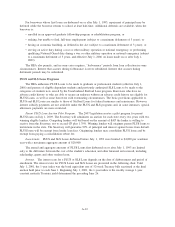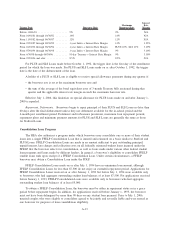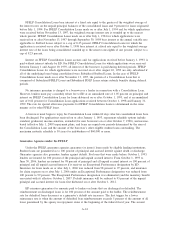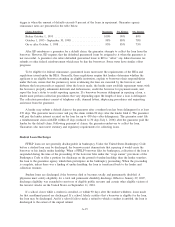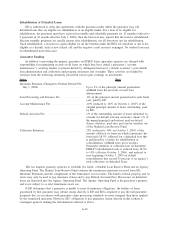Sallie Mae 2008 Annual Report Download - page 224
Download and view the complete annual report
Please find page 224 of the 2008 Sallie Mae annual report below. You can navigate through the pages in the report by either clicking on the pages listed below, or by using the keyword search tool below to find specific information within the annual report.• Mandates that both the transferor and transferee notify the borrower of certain transfer information
when a loan transfer changes the party with which the borrower needs to communicate or send
payments.
• Introduces a forgiveness program to repay FFELP loans and to cancel FDLP (except no parent PLUS
loans) at $2000 per year up to an aggregate of $10,000, for non-defaulted borrowers employed full
time in areas of national need (replacing the Child Care Loan Forgiveness Program). Subject to
appropriations.
• Authorizes repayment of FFELP loans (except parent PLUS loans) at $6,000 per year up to an
aggregate of $40,000 for attorneys employed full time as civil legal assistance attorneys. Subject to
appropriations.
• Requires reporting to consumer reporting agencies to indicate that a loan is an education loan and to
provide information on repayment status.
• Requires guarantors to develop educational programs for budgeting and financial management.
• Raises to 30% the school cohort default rate for ineligibility effective in 2012.
• Increases to 15% the maximum cohort default rate for exempting loans from rules that would otherwise
require multiple disbursement or delayed disbursement.
Eligible Lenders, Students and Educational Institutions
Lenders eligible to make loans under the FFELP generally include banks, savings and loan associations,
credit unions, pension funds and, under some conditions, schools and guarantors. A student loan may be made
to, or on behalf of, a “qualified student.” A “qualified student” is an individual who
• is a United States citizen, national or permanent resident;
• has been accepted for enrollment or is enrolled and maintaining satisfactory academic progress at a
participating educational institution; and
• is carrying at least one-half of the normal full-time academic workload for the course of study the
student is pursuing.
A student qualifies for a subsidized Stafford loan if his family meets the financial need requirements for
the particular loan program. Only PLUS loan borrowers have to meet credit standards.
Eligible schools include institutions of higher education, including proprietary institutions, meeting the
standards provided in the HEA. For a school to participate in the program, ED must approve its eligibility
under standards established by regulation.
Financial Need Analysis
Subject to program limits and conditions, student loans generally are made in amounts sufficient to cover
the student’s estimated costs of attending school, including tuition and fees, books, supplies, room and board,
transportation and miscellaneous personal expenses as determined by the institution. Generally, each loan
applicant (and parents in the case of a dependent child) must undergo a financial need analysis. This requires
the applicant (and parents in the case of a dependent child) to submit financial data to a federal processor. The
federal processor evaluates the parents’ and student’s financial condition under federal guidelines and
calculates the amount that the student and the family are expected to contribute towards the student’s cost of
education. After receiving information on the family contribution, the institution then subtracts the family
contribution from the student’s estimated costs of attending to determine the student’s need for financial aid.
Some of this need may be met by grants, scholarships, institutional loans and work assistance. A student’s
“unmet need” is further reduced by the amount of loans for which the borrower is eligible.
A-6



